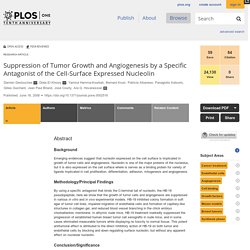

Potential role of HER2-overexpressing exosomes in countering trastuzumab-based therapy. - PubMed - NCBI. Potential role of HER2-overexpressing exosomes in countering trastuzumab-based therapy. - PubMed - NCBI. Exosomal evasion of humoral immunotherapy in aggressive B-cell lymphoma modulated by ATP-binding cassette transporter A3. Extracellular Vesicles Arising from Apoptotic Cells in Tumors: Roles in Cancer Pathogenesis and Potential Clinical Applications. The angiogenic function of nucleolin is mediated by vascular endothelial growth factor and nonmuscle myosin. - PubMed - NCBI. Suppression of Tumor Growth and Angiogenesis by a Specific Antagonist of the Cell-Surface Expressed Nucleolin.
Exosomes and Other Extracellular Vesicles in HPV Transmission and Carcinogenesis. Elevated cleaved caspase-3 is associated with shortened overall survival in several cancer types. How cell death shapes cancer. Extracellular Vesicles Arising from Apoptotic Cells in Tumors: Roles in Cancer Pathogenesis and Potential Clinical Applications. How cell death shapes cancer. The CD47-SIRPα Pathway in Cancer Immune Evasion and Potential Therapeutic Implications. Tumor-Associated Macrophages: From Mechanisms to Therapy: Immunity. Depletion of M2-Like Tumor-Associated Macrophages Delays Cutaneous T-Cell Lymphoma Development In Vivo - Journal of Investigative Dermatology.
Radiation Therapy for Cancer. Radiation can come from a machine outside the body (external-beam radiation therapy) or from radioactive material placed in the body near cancer cells (internal radiation therapy, more commonly called brachytherapy).

Systemic radiation therapy uses a radioactive substance, given by mouth or into a vein, that travels in the blood to tissues throughout the body. The type of radiation therapy prescribed by a radiation oncologist depends on many factors, including: The type of cancer.The size of the cancer.The cancer’s location in the body.How close the cancer is to normal tissues that are sensitive to radiation.How far into the body the radiation needs to travel.The patient’s general health and medical history.Whether the patient will have other types of cancer treatment.Other factors, such as the patient’s age and other medical conditions.
Apoptotic Cells Activate the “Phoenix Rising” Pathway to Promote Wound Healing and Tissue Regeneration. Exosomal transfer of tumor-associated macrophage-derived miR-21 confers cisplatin resistance in gastric cancer cells. Extracellular Vesicles Arising from Apoptotic Cells in Tumors: Roles in Cancer Pathogenesis and Potential Clinical Applications. Horizontal transfer of oncogenes by uptake of apoptotic bodies. Horizontal transfer of oncogenes by uptake of apoptotic bodies. Blebs produced by actin–myosin contraction during apoptosis release damage-associated molecular pattern proteins before secondary necrosis occurs. Autophagy promotes tumor cell survival and restricts necrosis, inflammation, and tumorigenesis: Cancer Cell. Principles and Current Strategies for Targeting Autophagy for Cancer Treatment. Principles and Current Strategies for Targeting Autophagy for Cancer Treatment.
Deconvoluting the context-dependent role for autophagy in cancer. Autophagy mitigates metabolic stress and genome damage in mammary tumorigenesis. Cancer-genome study challenges mouse 'avatars' : Nature News & Comment. Centre Jean Perrin/ISM/SPL A brain tumour called glioblastoma, shown here as the circular region in a patient's brain scan, is among the cancers that have been tested in mouse avatars.
An analysis of more than 1,000 mouse models of cancer has challenged their ability to predict patients’ response to therapy. The study, published today in Nature Genetics1, catalogues the genetic changes that occur in human tumours after they have been grafted into mouse hosts. Such models, called patient-derived xenografts (PDXs), are used in basic research and as ‘avatars’ for individual patients. Researchers use these avatar mice to test a bevy of chemotherapies against a person's tumour, in the hope of tailoring a treatment plan for the patient's specific cancer. “The assumption is that what grows out in the PDX is reflective of the bulk of the tumour in the patient,” says cancer geneticist Todd Golub, a lead author on the study. Does Surgery for Breast Cancer Induce Angiogenesis and Thus Promote Metastasis? - Abstract - Oncology 2011, Vol. 81, No. 3-4 - Karger Publishers. To view the fulltext, please log in To view the pdf, please log in Buy FullText & PDF Unlimited re-access via MyKarger Unrestricted printing, no saving restrictions for personal use read more Select Buy a Karger Article Bundle (KAB) and profit from a discount!

If you would like to redeem your KAB credit, please log in. Save over 20% compared to the individual article price. Mitochondrial Regulation of Cell Death. Suppression of Tumor Growth and Angiogenesis by a Specific Antagonist of the Cell-Surface Expressed Nucleolin. Abstract Background Emerging evidences suggest that nucleolin expressed on the cell surface is implicated in growth of tumor cells and angiogenesis.

Nucleolin is one of the major proteins of the nucleolus, but it is also expressed on the cell surface where is serves as a binding protein for variety of ligands implicated in cell proliferation, differentiation, adhesion, mitogenesis and angiogenesis. Methodology/Principal Findings. Midkine and pleiotrophin in neural development and cancer - Cancer Letters. Epdf?r3_referer=wol&tracking_action=preview_click&show_checkout=1&purchase_referrer=onlinelibrary.wiley.
Telomeres and Telomerase: The Cellular Timekeepers and Human Aging. Telomere shortening causes cellular senescence, making it a major candidate mechanism for a role in aging and a target for anti-aging interventions.

In this essay, I review current knowledge on telomere biology and discuss the possible role of telomeres and telomerase in human aging and in cancer. Sections Telomere Shortening As the Timekeeper of CellsHow Telomere Dysfunction Induces Cellular SenescenceUncapped Telomeres Recognized as DNA DamageAging, Cancer, and the Telomeres Keywords: ageing, biogerontology, cell aging clock, cytogerontology, terminal restriction fragments, TRF Telomere Shortening As the Timekeeper of Cells Early studies by Hermann Muller and Barbara McClintock showed that the ends of chromosomes are capped by a structure called the telomere to prevent chromosome fusions (Muller, 1938; McClintock, 1941). Figure 1: DNA polymerase requires an RNA primer to initiate synthesis in the 5'-3' direction. Olovkikov's model turned out to be incredibly accurate.
A matter of life and death: Cancer Cell. BensEPQProject. Aneuploidy and chromosomal instability in cancer: a jackpot to chaos. Chromosomal instability (CIN) refers to an increased rate of chromosome missegregation due to errors in mitosis [24, 25].

One of the main products of CIN is aneuploidy, a condition associated with the gain or loss of whole chromosomes or parts thereof leading to genomic imbalances (Fig. 1). There are many roads leading to CIN: multipolar spindles, improper chromosome condensation or cohesion, inefficient chromosome congression, defects in mitotic spindle assembly/dynamics, defective mitotic checkpoint and telomere attrition, replication stress, and improper kinetochore-microtubules attachments [25, 26, 27]. To add even more complexity, recent studies proposed that aneuploidy itself could lead to CIN (Fig. 1 and discussed below), suggesting the presence of a positive feedback loop resulting in increasing levels of aneuploidy.
A major question remains whether CIN is sufficient to initiate tumorigenesis? GetSharedSiteSession?rc=4&redirect= GetSharedSiteSession?rc=4&redirect= A caspase-independent way to kill cancer cells. New cancer treatment may be more effective than chemotherapy. A newly discovered process to trigger the death of cancer cells could be more effective than current methods such as chemotherapy, scientists have said.

The new method of killing cancer cells, called Caspase Independent Cell Death (CICD), led to the complete eradication of tumours in experimental models. Most current anti-cancer therapies (chemotherapy, radiation and immunotherapy) work by killing cancer cells through a process called apoptosis, which activates proteins called caspases, leading to cell death. However in apoptosis, therapies often fail to kill all cancer cells, leading to disease recurrence, and can also have unwanted side effects that may even promote cancer. Cancer Research's new ad is a live colonoscopy Scientists from the University of Glasgow wanted to develop a way to improve therapy that induces cancer cell killing while also mitigating unwanted toxicity.
The immune system can then attack the remaining tumour cells that evaded initial therapy-induced death. 9781936287857 chapter.